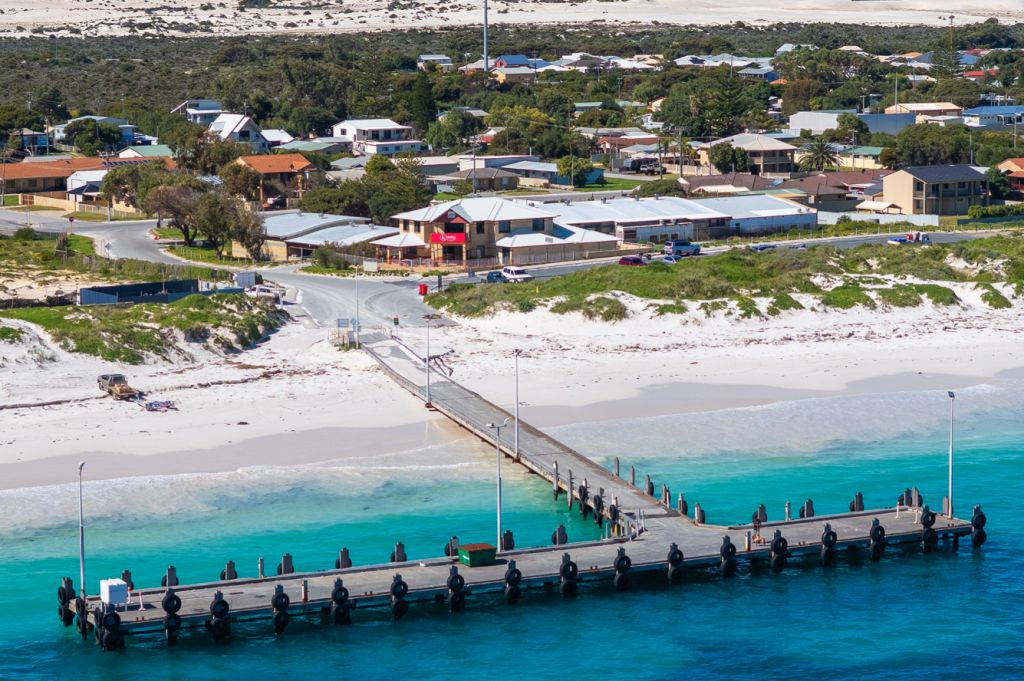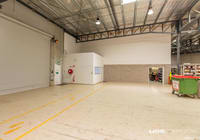
Lobsters on tap? WA foreshore cray depot has brewery approval
Where turquoise water meets Western Australia’s white sand dunes, a rare foreshore opportunity has come to market in Lancelin — a landmark site positioned to reshape the town centre and anchor the town’s next evolution.
With planning approval to build a brewery and more, the 7766-square-metre slice of beachfront at 64 Gingin Road is one of the most strategically positioned titles in the town, which sits 90 minutes north of Perth and is known for its pristine beaches, fishing, surfing and windsurfing.
The property, which will suit both owner-operators and developers, is for sale via expressions of interest with Ray White Lancelin’s Caroline Daniel, in conjunction with PSM Realty’s Phil Melville.
They say there’s “truly no comparable property in Western Australia”.
The long-held landholding is one of the only commercial development parcels in Lancelin that are zoned “Town Centre”. It has direct jetty access, sweeping Indian Ocean views, and a clear redevelopment pathway backed by an existing development approval.
The dual-fronted site includes five live lobster depots, fed by piped seawater and leased to major industry operators, with office and warehouse space across 963 square metres.
It also boasts a fully equipped 600-square-metre ground-floor restaurant, and a 2001 four-bedroom brick apartment with some of the most commanding vistas on the coast.
Daniel describes the home perched above the restaurant as “a very beautiful brick house built by Italians … the whole living area and kitchen overlook the jetty”. The buyer could lease it with the restaurant, let it on the short-stay market, ot keep it for their own use.
Breathe new life into Kerfuffle restaurant
Sitting beneath the residence, the former seafood venue Kerfuffle remains fully fitted out and ready for immediate reactivation after its operators fell on tough times during the pandemic.
“It was fine dining, and it became a household name … but it stopped during COVID,” Daniel says. “They walked away, leaving everything behind. But now, someone can just walk in and run the restaurant.”
The business is located in an ideal position, close to fresh lobsters awaiting live export after being offloaded by boats at the jetty and stored in aerated tanks. It is the perfect pit stop for tourists en route to the Pinnacles, thousands of ancient limestone pillars that rise from the desert floor in Nambung National Park, 50 minutes north.
While investors consider the site’s next chapter, flexible zoning opens the door to a wide range of commercial uses that align with Lancelin’s growing appeal as a tourism and residential hub. “You can even have a residence, so there are no particular restrictions,” Daniel adds.
The existing infrastructure provides an entry point for businesses seeking to enter or expand into the live lobster industry, with excess land available for further development.
Established in 1990 by the West Australian government to bolster the state’s $400 million rock lobster industry, the depots function as the key handover point for freshly caught lobster before export, supported by an adjacent office and warehouse facility. The depots are leased to three commercial tenants exporting the crustaceans to China and local markets. Long-term tenants include Geraldton Fisherman’s Co-operative and Kailis Bros (KB).
A DA that removes years of planning risk
A DA granted in late October 2024 removes years of planning risk and provides a fully endorsed pathway for a major mixed-use precinct. The plans include construction of a three-level 4000-square-metre boutique motel with a leisure deck; conversion of warehouse and offices to a 255-square-metre brewery, distillery or tavern; seven beachfront units with direct access to the beach and jetty with views to Lancelin Island; and five larger short-stay chalets created from the existing depot structures.
Daniel says the approval is notable given the tightly restricted nature of coastal planning.
“It’s very rare that in Western Australia that you have … property that is so close to the jetty,” she says. “For them to approve the accommodation and the brewery is already a big plus.”
The listing adds that, “as Western Australia’s population and development push northward, sites like this … are becoming almost impossible to secure”.
Coastal town at a turning point
Lancelin is experiencing a period of renewed popularity and infrastructure growth. “After COVID, Lancelin started to take off big time,” Daniel says, reflecting the rise in tourism, day-trippers and new residents.
This momentum has supported the creation of Lancelin South, a new township created by subdividing the town, which will bring shopping centres, schools and expanded medical services.
“I think a lot of people love Lancelin because it just feels so good,” Daniel adds, describing the town as a standalone coastal hub with a medical centre and school.
“It’s far enough to get away from Perth, and close enough to get back … a place where you can just come and let your hair down or just put your feet up and enjoy the yesteryear feel.”
The sales campaign is going well, she says, adding that there is already one offer on the table.
Lancelin’s dunes draw more than 200,000 visitors annually, and many of the Pinnacles’ 250,000 yearly visitors passing directly through the town. Up to five tour companies run daily trips through the coastal community.
The town’s overnight visitation reached 84,096 in 2022, despite Lancelin’s limited accommodation offerings – a motel, backpackers’ lodge and caravan parks – and lack of a brewery along the entire coastal stretch from Mindarie, 95 kilometres south, to Kalbarri, 460 kilometres north.
While Lancelin boasts what agents describe as an old-style tavern with a sports bar and restaurant, they point out the “untapped potential” of the coastal towns north of Perth – as evidenced by one particular success 85 kilometres further north in Cervantes. There, the popular Lobster Shack seats up to 500 people and serves up to 1200 meals a day.
Agents say establishing a brewery in Lancelin would be a “pioneering move”, offering a first-mover advantage in a region with proven tourism demand and minimal hospitality competition.











